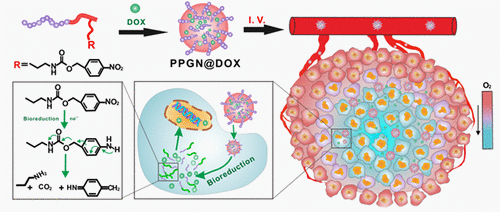当前位置:
X-MOL 学术
›
ACS Biomater. Sci. Eng.
›
论文详情
Our official English website, www.x-mol.net, welcomes your
feedback! (Note: you will need to create a separate account there.)
Hypoxia-Responsive Polypeptide Nanoparticles Loaded with Doxorubicin for Breast Cancer Therapy
ACS Biomaterials Science & Engineering ( IF 5.4 ) Pub Date : 2020-03-10 , DOI: 10.1021/acsbiomaterials.0c00125 Peng Zhang 1, 2 , Huailin Yang 1 , Wei Shen 1, 3 , Wanguo Liu 4 , Li Chen 5 , Chunsheng Xiao 1, 2
ACS Biomaterials Science & Engineering ( IF 5.4 ) Pub Date : 2020-03-10 , DOI: 10.1021/acsbiomaterials.0c00125 Peng Zhang 1, 2 , Huailin Yang 1 , Wei Shen 1, 3 , Wanguo Liu 4 , Li Chen 5 , Chunsheng Xiao 1, 2
Affiliation

|
Microenvironments of various solid tumors are characterized by hypoxia. Herein, we report a novel nanoparticle that can selectively release loaded drugs in hypoxic environments. The nanoparticle was prepared using a hypoxia-responsive amphiphilic polymer in aqueous media. The polymer was synthesized by conjugating a hydrophobic small molecule, 4-nitrobenzyl (3-azidopropyl) carbamate, to the side chains of an mPEG-PPLG copolymer. Doxorubicin (DOX) could be loaded into the nanoparticles with a high efficiency of 97.8%. The generated drug-loaded micellar nanoparticles (PPGN@DOX) presented hypoxia-sensitive drug release behavior in vitro. Meanwhile, PPGN@DOX could be effectively internalized by 4T1 cells and could release DOX into the cell nuclei under hypoxic conditions. The in vitro anticancer results suggested that PPGN@DOX presented superior tumor cell-killing ability compared with free DOX in hypoxic environments. Furthermore, PPGN@DOX prolonged the blood circulation time and improved the biological distribution of DOX, resulting in increased antitumor outcomes and reduced side effects in vivo. Overall, the present work demonstrates that hypoxia-responsive nanoparticles have great application potential in the treatment of hypoxic tumors.
中文翻译:

负载阿霉素的缺氧响应性多肽纳米颗粒在乳腺癌治疗中的作用
各种实体瘤的微环境以缺氧为特征。在本文中,我们报道了一种新型的纳米颗粒,可以在低氧环境中选择性释放负载的药物。使用缺氧响应性两亲聚合物在水性介质中制备纳米颗粒。通过将疏水性小分子4-硝基苄基(3-叠氮基丙基)氨基甲酸酯与mPEG-PPLG共聚物的侧链缀合来合成聚合物。阿霉素(DOX)可以以97.8%的高效率装载到纳米颗粒中。产生的载药胶束纳米粒子(PPGN @ DOX)在体外表现出对缺氧敏感的药物释放行为。同时,PPGN @ DOX可以被4T1细胞有效地内在化,并且可以在低氧条件下将DOX释放到细胞核中。体外抗癌结果表明,PPGN @ DOX在缺氧环境中具有比游离DOX更好的杀死肿瘤细胞的能力。此外,PPGN @ DOX延长了血液循环时间并改善了DOX的生物分布,导致体内抗肿瘤效果增强,副作用减少。总的来说,目前的工作表明低氧反应性纳米颗粒在低氧肿瘤的治疗中具有巨大的应用潜力。
更新日期:2020-03-10
中文翻译:

负载阿霉素的缺氧响应性多肽纳米颗粒在乳腺癌治疗中的作用
各种实体瘤的微环境以缺氧为特征。在本文中,我们报道了一种新型的纳米颗粒,可以在低氧环境中选择性释放负载的药物。使用缺氧响应性两亲聚合物在水性介质中制备纳米颗粒。通过将疏水性小分子4-硝基苄基(3-叠氮基丙基)氨基甲酸酯与mPEG-PPLG共聚物的侧链缀合来合成聚合物。阿霉素(DOX)可以以97.8%的高效率装载到纳米颗粒中。产生的载药胶束纳米粒子(PPGN @ DOX)在体外表现出对缺氧敏感的药物释放行为。同时,PPGN @ DOX可以被4T1细胞有效地内在化,并且可以在低氧条件下将DOX释放到细胞核中。体外抗癌结果表明,PPGN @ DOX在缺氧环境中具有比游离DOX更好的杀死肿瘤细胞的能力。此外,PPGN @ DOX延长了血液循环时间并改善了DOX的生物分布,导致体内抗肿瘤效果增强,副作用减少。总的来说,目前的工作表明低氧反应性纳米颗粒在低氧肿瘤的治疗中具有巨大的应用潜力。











































 京公网安备 11010802027423号
京公网安备 11010802027423号